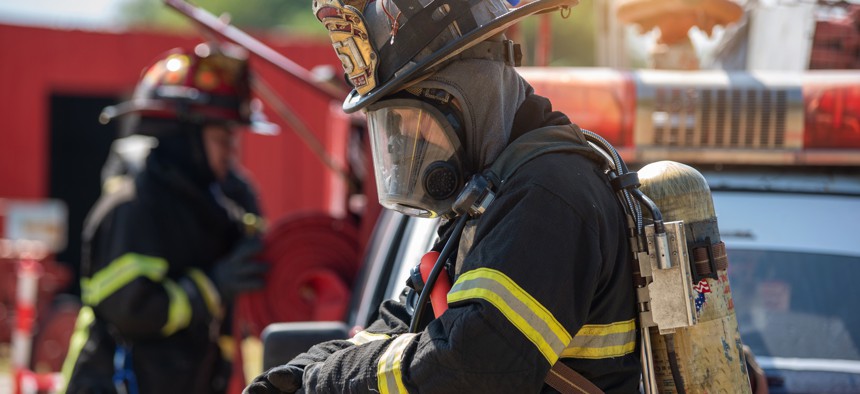Choosing the right mobile tech to enhance first responder workflows

GettyImages/boonchai wedmakawand
Flexible and modular devices can improve responders’ efficiency and situational awareness while future-proofing a municipality’s investments.
About 240 million 911 calls are made in the U.S. each year, and many local agencies have recently seen this volume increase. Depending on the week, Portland, Oregon, for instance, saw a 20% to 45% increase in emergency calls from 2020 to 2021.
Amid the growing number of calls, first responders also confront significant staffing and resourcing shortages. A national survey of police agencies found that between 2020 and 2021, fewer officers were hired, while resignations and retirements increased. Similarly, a 2021 survey by the American Ambulance Association found that nearly a third of the workforce left their ambulance company after less than a year in 2020.
All the while, more than 60% of first responders say their jobs have become harder over the past 18 months, emphasizing the need for more collaboration and more efficient information sharing.
Equipping first responders with the right mobile technology is key to helping them perform their jobs more efficiently. These solutions support increased situational awareness by facilitating access to critical information and enabling quality communication in real-time.
Finding the right combination of durability and performance
Responders often operate in outdoor environments amid all types of weather conditions, so it’s not enough for solutions to be high-tech. They must also be rugged and able to withstand the elements. The ability to withstand drops and spills boosts daily performance and ensures a lower total cost of ownership, limiting the number of repairs and replacements IT teams have to make.
In addition to unpredictable weather, first responders must navigate an array of situations from dimly lit nighttime environments to bright sunlight, from quiet to loud. Therefore, user experience is critically important to consider.
Powerful speakers and microphones ensure that communications are received and dispatched clearly even amid loud sirens and high-traffic scenes. Similarly, screens that offer a high degree of readability in direct sunlight and can be dimmed for discrete nighttime use reduce eye fatigue and promote productivity across shifts at any time. Efficient heat management supports long-term use for an extended shift or when passing the device off to a colleague for the next shift. Enhanced computing performance and processing power enable quick file upload and download, boosting overall efficiency and ease-of-use.
Devices with multiple cellular and connectivity options, including 4G LTE and 5G with dedicated first responder networks and dual SIM capabilities, are critical to help first responders maintain communication and access information in real-time.
The flexibility and ROI afforded by modularity
From drones and thermal imaging to virtual reality and artificial intelligence, advanced technologies are transforming workflows for first responders. These emerging applications have not yet seen full adoption across the industry, with agencies all at different stages in their deployment processes. The same level of variability applies to more mainstream technology as well, such as backwards compatibility for any situations where legacy ports are still in use.
Rugged mobile devices pair well with current and emerging technology applications. However, agencies can’t replace their device fleet every time requirements change. Thus, it’s important to find devices that are modular in nature. These solutions feature a flexible design that allows for the addition of new components and capabilities as roles, functionalities and needs evolve. For instance, if security requirements change and departments need devices with an extra authentication factor, they can easily add a smart card reader to their existing modular laptops instead of purchasing an entirely new fleet of devices.
Modular devices are often compatible with older and newer components, which is critical given that there may not always be room in municipal budgets to purchase new accessories alongside an updated device fleet. By increasing the longevity of a device, modularity can also decrease the burden on IT teams, requiring them to spend less time researching and deploying new device fleets.
Supporting the mobile workstation of the future
Mobile workstations make it possible for first responders to accomplish more from the field. Ambulances, fire trucks and police cars are evolving to support first responders’ productivity needs wherever the job takes them. Mobile devices can send and process key information responders may need to access onsite – from building floor plans, to electric car schematics and updated warrants. This information ultimately enables informed critical decision-making. Furthermore, mobile workstations streamline the reporting process, enabling first responders to send reports from the vehicle in near-real time, increasing productivity and accuracy.
In-vehicle docking demands also vary depending on the use case. For some, particularly vehicles that are used in back-to-back shifts, laptop docking may be permanent. For others, where flexibility is more important, the right mounting capabilities for easy removal and re-docking are imperative. In these scenarios, first responders can easily remove devices and utilize them outside the vehicle. For example, officers can use built-in barcode scanners to streamline the ticket-issuing process, and firefighters can use the devices to control a drone that’s surveying the progression of a distant fire.
Supporting first responders with the right mobile technology goes a long way in achieving greater levels of efficiency and situational awareness. IT teams looking to future-proof their investments can turn to flexible and modular devices to make sure their teams can take advantage of the latest tech solutions for years to come.
Marcus Claycomb serves as the Business Development Manager for Public Sector at Panasonic Connect.





